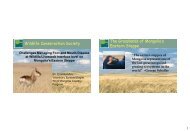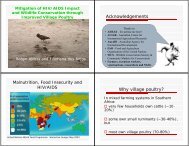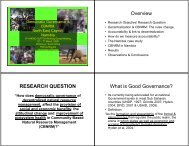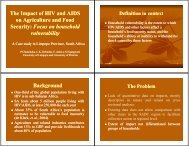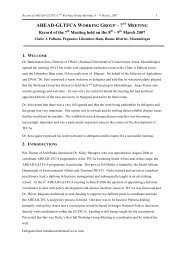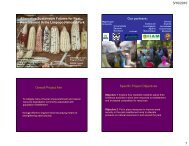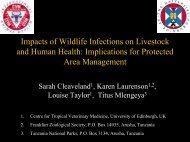Download - Animal & Human Health for the Environment and ...
Download - Animal & Human Health for the Environment and ...
Download - Animal & Human Health for the Environment and ...
Create successful ePaper yourself
Turn your PDF publications into a flip-book with our unique Google optimized e-Paper software.
5. Porcine diseases 5.1 African swine fever (ASF) African swine fever (ASF) is one of <strong>the</strong> most feared diseases of pigs. It manifests as an acute haemorrhagic fever with high mortality <strong>and</strong> is caused by a unique DNA virus, Asfivirus, <strong>the</strong> only known member of <strong>the</strong> family Asfarviridae. Subacute <strong>and</strong> chronic <strong>for</strong>ms have been described, mainly in Europe, but are not commonly seen in Africa (Penrith et al. 2004). ASF is present or has been reported from most sub-‐Saharan countries where pigs are kept, including some of <strong>the</strong> isl<strong>and</strong>s that <strong>for</strong>m part of <strong>the</strong> region. In 1957 <strong>and</strong> again in 1960 it reached Portugal from Angola <strong>and</strong> subsequently infected several European countries as well as Cuba, Haiti, Dominican Republic, <strong>and</strong> Brazil. It was eradicated from all except <strong>the</strong> Italian isl<strong>and</strong> of Sardinia, where it is considered endemic. In 2007 ASF was diagnosed in <strong>the</strong> Republic of Georgia with subsequent spread throughout <strong>the</strong> Caucasus as well as alarming spread in Russia, where it appears to have become endemic (S. Dudnikov, pers. comm. 2011). ASF is endemic in warthogs (Phacochoerus africanus) in most countries of eastern <strong>and</strong> sou<strong>the</strong>rn Africa, with a sylvatic cycle occurring between neonatal warthogs <strong>and</strong> ticks of <strong>the</strong> Ornithodoros moubata complex that live in <strong>the</strong> warthog burrows <strong>and</strong> can transmit <strong>the</strong> virus to domestic pigs. It is also endemic in domestic pigs in many sub-‐Saharan African countries where Ornithodoros moubata lives in pig shelters <strong>and</strong> also where <strong>the</strong>re are large enough continuous populations of pigs to sustain circulation of <strong>the</strong> virus. Infected domestic pigs are potent sources of virus <strong>and</strong> transmission commonly occurs through direct contact or by consuming <strong>the</strong> flesh of pigs that have died of ASF. Secondary transmission by humans or fomites is probably common, <strong>and</strong> mechanical transmission by stable flies (Stomoxys calcitrans) but not by o<strong>the</strong>r biting insects has been demonstrated. Warthogs are impervious to <strong>the</strong> pathogenic effects of <strong>the</strong> virus, as are o<strong>the</strong>r African wild pigs (bush pigs [Potamochoerus spp.] <strong>and</strong> giant <strong>for</strong>est hog [Hylochoerus meinertzhageni]). Warthogs are unable to transmit <strong>the</strong> virus directly to domestic pigs but transmission occurs when infected Ornithodoros feed on <strong>the</strong> blood of domestic pigs. No role in natural infection has been demonstrated <strong>for</strong> bush pigs or giant <strong>for</strong>est hogs (<strong>the</strong> latter have a restricted distribution range <strong>and</strong> are unlikely to come into contact with domestic pigs). Among <strong>the</strong> KAZA countries, ASF outbreaks are associated exclusively with warthogs in Botswana <strong>and</strong> Namibia. This was also <strong>the</strong> case in Zimbabwe, but <strong>the</strong> last outbreak <strong>the</strong>re was reported in 1977. Warthog involvement has never been documented in Angola, where outbreaks are generally associated with movement of infected domestic pigs <strong>and</strong> <strong>the</strong>ir products. ASF is endemic in domestic pigs in <strong>the</strong> Eastern Province of Zambia <strong>and</strong> <strong>the</strong> adjacent areas of Malawi <strong>and</strong> Mozambique, in association with Ornithodoros ticks that live in pig shelters. Outbreaks in <strong>the</strong> rest of <strong>the</strong> country have been associated with movement of pigs <strong>and</strong> pig products. ASF is endemic in all <strong>the</strong> neighbouring countries, but in South Africa it is restricted to a defined zone in <strong>the</strong> north-‐eastern part of <strong>the</strong> country, mainly in Limpopo Province, in which <strong>the</strong> sylvatic cycle occurs. The remaining countries all have endemic ASF in domestic 33



